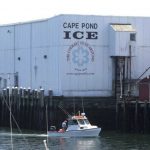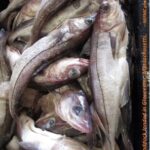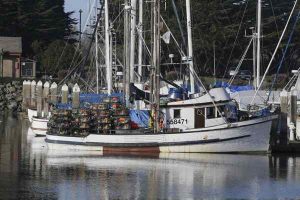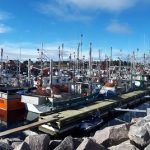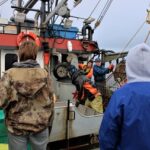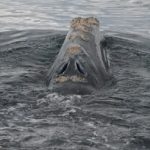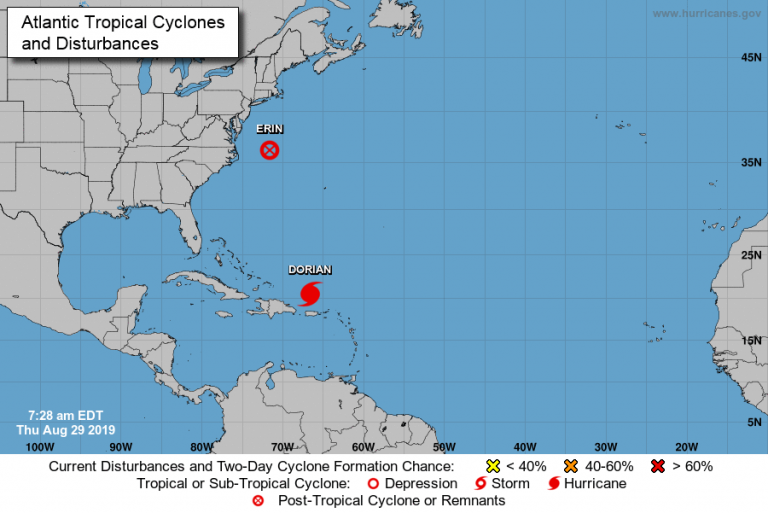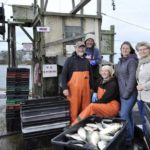Search Results for: Darren Porter
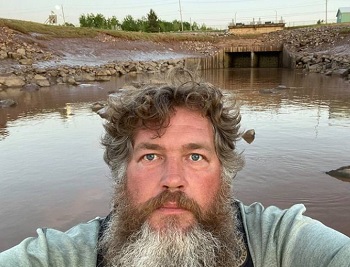
Fisherman Darren Porter has been keeping a one-man vigil at the Windsor causeway since last Thursday
The Hants County weir fisherman and marine science data collector has been floating in his open boat up to 20 hours a day to raise awareness for the lack of fish being allowed up the Avon River. “About six minutes on a tide,” said Porter of the amount of time the big gates in the Windsor causeway are opened to allow water through. That, he argues, is not enough time to allow the inner Bay of Fundy salmon, shad, gaspereau, striped bass and tom cod to get up the Avon River. That also, he argues, puts the operators of the gates (Department of Agriculture) in violation of the federal Fisheries Act. >click to read< 09:03
Fisherman Darren Porter fears gate closures killing fish – “Once you see enough of it, it’s hard to watch.”
The Hants Journal – Darren Porter fishes in the Avon River for gaspereau five days a week in April and May. He first approached the Hants Journal with concerns that the gatekeeping practices at the causeway were causing large numbers of fish to die in May 2011.  Porter says smaller gate openings more often allow for the best possible fish passage into spawning grounds upstream, but that’s not what he’s been seeing this spring. “Once you see enough of it, it’s hard to watch.” continued
Porter says smaller gate openings more often allow for the best possible fish passage into spawning grounds upstream, but that’s not what he’s been seeing this spring. “Once you see enough of it, it’s hard to watch.” continued
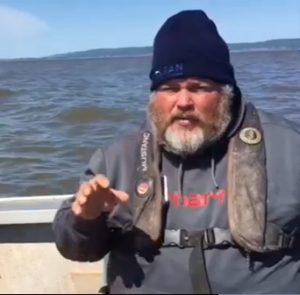
Porter family fights for safe passage of fish in the Minas Basin
When Darren Porter knows the tide and water temperature are right for the gaspereau to make their run, he calls the Department of Agriculture staff person capable of opening the gates in the causeway across the Avon River. “If it’s convenient for them to listen to me they open them, if it’s not they don’t,” said the Hants County fisherman. “All I can do is make the call and hope the fish get a chance to fulfil their life cycle.” For Porter the battle for fish passage in the Avon River is already largely lost. >click to read< 11:17

Caretakers of their waterways: Two Nova Scotians granted visionary awards
Dec. 9 Darren and Erica Porter were freezing their keesters off in their aluminum dory as academics and fisheries managers with the Gulf of Maine Council on the Marine Environment bestowed a Visionary Award on him via Zoom. The other Nova Scotian recipient of the award was further up the Bay of Fundy. Like Porter, through his years working with the Clean Annapolis River Project, Levi Cliché has learned as much about working with people and institutions as he has about the ecosystem he cares for. >click to read< 10:38 More posts of Darren Porter and real activism to stop tidal turbines and fighting for the safe passage of fish, >click to read them all<.
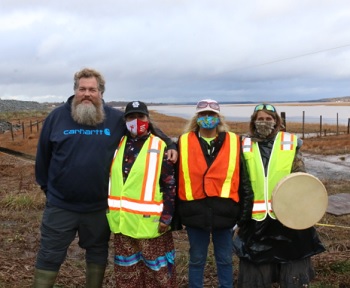
Highway 101 shut down as Avon River causeway protestors urge action to allow free fish passage
On Nov. 16, Howe was among the dozens of people who gathered to hold a ‘respectful, reduced traffic flow’ on Highway 101. The majority of traffic was detoured but some trickled through, starting and stopping in six-minute intervals to reflect the short time frame that fish have to pass through the gated structure. It was an inconvenience to many motorists – but according to fisherman Darren Porter, it was a necessary move. “At the end of the day, how else do you get media here?” asked Porter, while surrounded by water defenders. Porter has been drawing attention to the limited fish passage in Windsor for several years. >click to read< 07:38
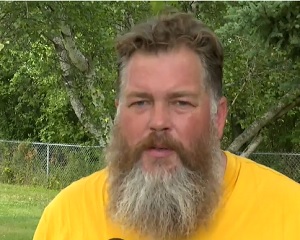
Nova Scotia: Residents raise alarm over causeway’s threat to local fish stocks
“This river is already dying, we’re already losing all of our fish, and along with losing all of our fish, we’re losing our rights as well,” said Nikki Lloyd, of the Annapolis Valley First Nation. Darren Porter, a local fisherman and fishery spokesperson for the Fundy United Federation, said over many years, he’s seen a reduction in productivity for both professional and recreational fishers. Government efforts, he alleged, to improve passage times have fallen short of what’s required to keep the ecosystem healthy. >click to read< 13:08
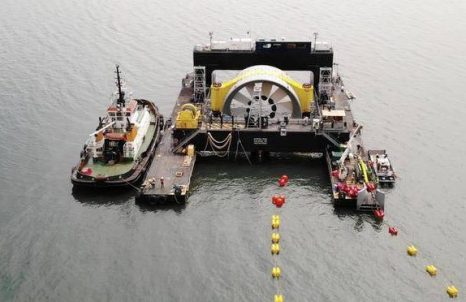
“That turbine was put down there in bad faith.” – Cape Sharp Tidal owner files for bankruptcy in Ireland
A week after a massive tidal turbine was placed in the Minas Passage, its owners have filed for bankruptcy. Local contractors, marine service companies, motels, fishermen and other business people are owed an undetermined amount of money. OpenHydro owns 97 per cent of Cape Sharp Tidal, with the remaining three percent owned by Emera, Nova Scotia Power’s parent company.,, Fishermen claim they were told the turbine would not be installed at the Force site in the Minas Passage until the close of the lobster season at the end of July. “They used all these local resources, hired all these local business people, drove right over all that local lobster gear and they never intended to pay nobody,” said Darren Porter, spokesman for the Fundy United Federation, a fishermen’s organization. One contractor, who didn’t want his named used, estimated that OneHydro owes “tens of millions of dollars” to local companies. >click to read<22:11
Fundy Tidal tests on hold, more consultations to be held before turbine launch
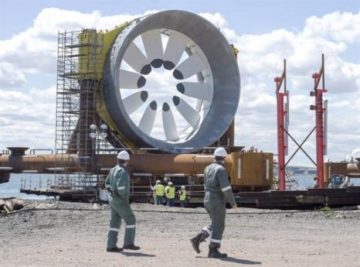 Cape Sharp Tidal has put the brakes on the deployment of its first turbine in the Bay of Fundy, originally set for this weekend so it can meet with concerned community members. Sarah Dawson, community relations manager with Cape Sharp Tidal told the Chronicle Herald Thursday that despite extensive outreach activities, there are still stakeholders in the region that feel like they have not been fully heard. “We are taking a pause to. . .hear from those who don’t feel like they have an opportunity. It’s important that we listen and we learn and we always learn from these sorts of engagements,” Dawson said in an interview. (then they’ll stick it in!) Dawson wouldn’t say how long they will be delaying the deployment. “It’s a positive step,” said Minas Basin weir fisherman Darren Porter. Read the rest here 19:05
Cape Sharp Tidal has put the brakes on the deployment of its first turbine in the Bay of Fundy, originally set for this weekend so it can meet with concerned community members. Sarah Dawson, community relations manager with Cape Sharp Tidal told the Chronicle Herald Thursday that despite extensive outreach activities, there are still stakeholders in the region that feel like they have not been fully heard. “We are taking a pause to. . .hear from those who don’t feel like they have an opportunity. It’s important that we listen and we learn and we always learn from these sorts of engagements,” Dawson said in an interview. (then they’ll stick it in!) Dawson wouldn’t say how long they will be delaying the deployment. “It’s a positive step,” said Minas Basin weir fisherman Darren Porter. Read the rest here 19:05
The Fight Rages On As Byler Inches Closer To A Federal Trial Against The US Coast Guard And City of Kodiak
 In late 2022 and early 2023, Professional Mariner Darren Byler of Kodiak, Alaska filed two separate multi-million-dollar lawsuits: one against the United States Coast Guard and Special Agents for fraud and evidence tampering and the other against City of Kodiak and City Officials for the illegal sinking of the 110’ M/V Wild Alaskan. Byler claims both cases are related and he was “ganged up on by all of them at once over my Adult Entertainment Charter”. “I did not realize that beautiful, topless women could be so threatening and intimidating to certain people”.
In late 2022 and early 2023, Professional Mariner Darren Byler of Kodiak, Alaska filed two separate multi-million-dollar lawsuits: one against the United States Coast Guard and Special Agents for fraud and evidence tampering and the other against City of Kodiak and City Officials for the illegal sinking of the 110’ M/V Wild Alaskan. Byler claims both cases are related and he was “ganged up on by all of them at once over my Adult Entertainment Charter”. “I did not realize that beautiful, topless women could be so threatening and intimidating to certain people”.
As an Investigative Reporter for Maritime Justice, I have been following this story for several months as Byler has methodically laid out details of his claims of fraud and misconduct against the US Coast Guard and the City of Kodiak on the “Sinking of the Wild Alaskan” Facebook page. Byler has used their own documents against them in a total of “28 Document Dumps”. Most of the documents, photos and audio recordings Byler has posted were obtained by Byler in the Federal Discovery Process, as well as Freedom of Information Act requests.
It would appear that Darren Byler has successfully applied hard-hitting evidence against all involved in this case coupled with his undeniable sense of humor, “I’m not a lawyer but I did just recently stay at a Holiday Inn Express”. Byler has a full-court press going after elected and hired public officials which includes City, State and Federal Law Enforcement Officers that Byler claims, “are covering up many State and Federal Felonies in this case” and “we are now obviously living in a Two-Tier Justice System”.
This is a David and Goliath Story, without the help of an attorney or law firm, Byler is single handedly fighting two separate Motions to Dismiss: one by the US Coast Guard and the other by the City of Kodiak. Byler has now filed two separate Oppositions to Motion to Dismiss along with answering many additional side motions which are now pending in the District of Alaska Federal Court in Anchorage, Alaska.
 Byler now claims that not only does he have to fight the City and the Feds at the same time, Byler states, “Our local newspaper the Kodiak Daily Mirror is in the tank for the other side trying to sway Public Opinion and curry favor with those that pay their bills”. Byler says, “I cannot get a fair article even with the overwhelming evidence in my favor.” Byler has been at odds for many months with Kodiak Daily Mirror Publisher Kevin Bumgarner over what Byler states are “one sided articles” and “printing false information”. Byler has even on more than one occasion portrayed Bumgarner in a Court Jester Hat on the “Sinking of the Wild Alaskan” Facebook page. Underneath, the photo of Bumgarner, Byler writes, “ A Free Press that suppresses corruption associated with Government Officials will always have a negative
Byler now claims that not only does he have to fight the City and the Feds at the same time, Byler states, “Our local newspaper the Kodiak Daily Mirror is in the tank for the other side trying to sway Public Opinion and curry favor with those that pay their bills”. Byler says, “I cannot get a fair article even with the overwhelming evidence in my favor.” Byler has been at odds for many months with Kodiak Daily Mirror Publisher Kevin Bumgarner over what Byler states are “one sided articles” and “printing false information”. Byler has even on more than one occasion portrayed Bumgarner in a Court Jester Hat on the “Sinking of the Wild Alaskan” Facebook page. Underneath, the photo of Bumgarner, Byler writes, “ A Free Press that suppresses corruption associated with Government Officials will always have a negative
effect on Society. This is a fact that no one can argue with.”
In the last front page news article regarding Byler and the Wild Alaskan, the Kodiak Daily Mirror headline reads “City seeks to dismiss Byler lawsuit”
Byler claims, that 95% of the article is irrelevant and nonsensical claims by the City’s Attorney while they try to cover their tracks while committing fraud.” As well as, “regurgitating the fraudulent poop crimes against humanity conviction against me as if that had anything to do with the City’s Motion to dismiss my case against them.” Byler has provided to Maritime Justice a copy of an email chain between himself and the Kodiak Daily Mirror before their article was printed. Both Publisher Kevin Bumgarner and Reporter Caleb Oswell were well aware of Byler’s extensive Opposition to the City of Kodiak’s Motion to Dismiss citing multiple Federal case law and Federal Law documenting the fact that Maritime Law supersedes Kodiak City Ordinances regarding vessels all before the Publisher printed the article. Unfortunately for Byler, his hometown newspaper did not report on his response to the City.
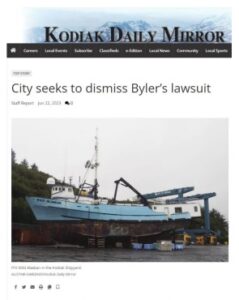 There has also been a new development in this story, Longtime Kodiak Mariner Tim Abena has just come forward and publicly validated Byler’s claims that the 110’ M/V Wild Alaskan was illegally seized by the order of City of Kodiak Mayor Pat Branson. Mr. Abena made public statements in a paid article published June 20, 2023 in the Kodiak Daily Mirror. As Abena sat on the Kodiak Ports and Harbors Advisory Board, Tim Abena claims he received information from “other City Officials” that Byler’s boat was illegally seized by the orders of Mayor Pat Branson after a verbal disagreement at the local Kodiak Safeway the evening before. Byler claims he knows exactly who the other City Officials are and it will come out in the discovery and deposition process. Abena writes, “The list of questions is a long one with serious
There has also been a new development in this story, Longtime Kodiak Mariner Tim Abena has just come forward and publicly validated Byler’s claims that the 110’ M/V Wild Alaskan was illegally seized by the order of City of Kodiak Mayor Pat Branson. Mr. Abena made public statements in a paid article published June 20, 2023 in the Kodiak Daily Mirror. As Abena sat on the Kodiak Ports and Harbors Advisory Board, Tim Abena claims he received information from “other City Officials” that Byler’s boat was illegally seized by the orders of Mayor Pat Branson after a verbal disagreement at the local Kodiak Safeway the evening before. Byler claims he knows exactly who the other City Officials are and it will come out in the discovery and deposition process. Abena writes, “The list of questions is a long one with serious
implications” and “During my eight years of participation on PHAB(Ports and Harbors Advisory Board) I learned about many questionable city practices, manipulations of events” and found Byler’s event to be “particularly egregious”.
Most cases in Civil Court are won or lost by the decision of a Judge to allow the case to move on to trial. At that time, a majority of the cases settle out of court. Both of Byler’s cases are now pending a decision to move forward to trial by two separate Federal Judges. Byler has now posted his 32-page Opposition to Motion to Dismiss by the City of Kodiak on the Sinking of the Wild Alaskan Facebook page. Maritime Justice has examined and researched Byler’s assertions closely and has concluded that Darren Byler has a compelling argument.
Maritime Justice will continue to follow this story as it develops. Both the US Coast Guard and City Officials declined comment. Story by John Beck
Nils E. Stolpe: Flotsam and Jetsam FishNet-USA/December 8, 2013
 “Flotsam is floating wreckage of a ship or its cargo. Jetsam is part of a ship, its equipment, or its cargo that is purpose-fully cast overboard or jettisoned to lighten the load in time of distress and that sinks or is washed ashore” (http://en.wikipedia.org/wiki/
“Flotsam is floating wreckage of a ship or its cargo. Jetsam is part of a ship, its equipment, or its cargo that is purpose-fully cast overboard or jettisoned to lighten the load in time of distress and that sinks or is washed ashore” (http://en.wikipedia.org/wiki/
I use this title for periodic FishNets in which I address several issues that should be of value to anyone with an interest in oceans and fisheries in a somewhat abbreviated manner.
________________________
Please feel free to reproduce or redistribute this issue of FishNet USA or any others. The only requirement is that you cite the source fully as above. To be removed from this distribution list, please reply to this email with “remove” in the subject line.
_______________________
More astroturf “activism” in herring management
Wikipedia – “Astroturfing is the practice of masking the sponsors of a message (e.g. political, advertising, or public relations) to give the appearance of it coming from a disinterested, grassroots participant. Astroturfing is intended to give the statements the credibility of an independent entity by withholding information about the source’s financial connection.”
It was not quite a year ago that I wrote The Forage Fish Fakeout (http://www.fishnet-usa.com/
A listing of the foundation-funded “research activities” that I compiled last year:
• 1998 – Conservation Law Foundation – $30,000 – “To promote responsible herring management.”
• 2004 – National Coalition for Marine Conservation – $558,000 – “To secure an amendment to the Interstate Menhaden Management Plan that would reduce or eliminate fishing of menhaden in the Chesapeake Bay, in order to protect the broader ecosystem of the Bay.”
• 2004 – Aquatic Farms Limited – $142,000 – “To assess the amount of competition between catch of small forage fish for direct human consumption and for reduction into fishmeal and fish oil for use as aquaculture and agriculture feed.”
• 2004 – Research Foundation of the State University of New York, Stony Brook – $750,000 – “To establish the Lenfest Forage Fish Task Force that will develop and recommend ecosystem-based standards for the sustainable management of forage fisheries.”
• 2004 – Research Foundation of the State University of New York, Stony Brook $145,000 –
“To advance ecosystem-based fishery management by evaluating the status of understudied fish and other marine species in several regions of the United States that are impacted by the commercial fishing industry.”
• 2005 – National Coalition for Marine Conservation – $200,000 – “To ensure a new regulatory cap on the industrial harvest of Atlantic menhaden is implemented and enforced.”
• 2006 – National Coalition for Marine Conservation – $100,000 – “To support efforts to initiate new regulatory actions that will preserve adequate populations of forage fish which support healthy populations of predators, including numerous species of marine mammals, seabirds and fish.”
• 2006 – Gulf Restoration Network – $210,000 – “To support efforts to stop overfishing, secure conservation-based limits on unintended bycatch of marine life, and to conduct research and prepare a report on management reforms needed in the Gulf of Mexico menhaden fishery to reduce harvests to protect the forage needs of menhaden predators and reduce bycatch of sharks and marine mammals.”
• 2007 – Cape Cod Commercial Hook Fishermens Association – $180,000 – “To provide general operating support policy reform campaigns for herring and groundfish.”
• 2007 – Cape Cod Commercial Hook Fishermens Association – $596,000 – “To support a New England forage fish campaign to ban or severely restrict destructive trawling, reduce allowable herring catches.”
• 2008 – Research Foundation of the State University of New York, Stony Brook – $3,000,000 – “To conduct scientific research regarding sustainable fisheries management and conservation of threatened and endangered fish.”
• 2008 – Cape Cod Commercial Hook Fishermens Association – $722,000 – “To support activities to reform the Atlantic herring fishery.”
• 2008 – Earthjustice – $212,000 – “To reform New England’s Atlantic herring fishery.”
• 2008 – Marine Fish Conservation Network – $125,000 – “For work intended to ensure the full implementation of the Magnuson-Stevens Reauthorization Act and to promote the sustainable management of forage fish species ($100,000) and for general support ($25,000)”
• 2009 – National Coalition for Marine Conservation – $30,000 – “To develop guidance for conservation of forage fish through an ecosystem-based approach to fisheries management.”
Note that of the over seven million dollars in “research” listed above none is devoted to contributing to the basic biology of forage fish, the fisheries or the fishermen they interact with. It’s apparently a foregone conclusion in some circles – not, of course, in the circles populated by the scientists and bureaucrats who are responsible for managing our fisheries – that catching forage fish is bad. This apparently is regardless of other factors like what’s really going on in our oceans, what conservation measures have already been adopted by the fishermen or how effective they have proven to be.
Because the fisheries management establishment has refused to take the word of the Pew claque that these fisheries need to be shut down, in the intervening years the pressure to do that has been characteristically relentless – and characteristically expensive. In the latest example of Pew formed/funded organizations jumping on the “get the forage fishermen” bandwagon, Earthjustice just announced a lawsuit in which it is representing several small recreational fishing groups, claiming that by the Council’s declining to move ahead with Amendment 15 to the Mackerel, Squid and Butterfish Fishery Management Plan, NMFS is not providing adequate measures to “protect*” blueback herring and alewife and American and Hickory shad.” This is in spite of the fact that both the Mid-Atlantic Fishery Management Council and NMFS fully explained their reasons for proceeding as they have been and extending assurances that the management provisions now in place would adequately protect both river herring and shad (for more on this see Is this any way to manage a fishery? at http://www.fishnet-usa.com/Any way to manage.pdf).
Of course this isn’t good enough for the Pew people. Who needs solid science if you have that sense of righteous indignation that generally accompanies cashing those huge checks? Should it surprise anyone to learn that Earthjustice has received over $20 million from Pew?
I guess if you have a few billions of dollars in the bank you kind of believe that things should be run your way, even if you had nothing to do with – or maybe because you had nothing to do with – earning any of those dollars yourself.
(For a surprisingly rational discussion of the forage fish issue on the west coast, see Glen Martin’s blog on the Huffington Post website titled Of Little Fish, Cute Mammals, and the Law of Unintended Consequences at http://www.huffingtonpost.com/
*Neither of which are considered endangered or threatened.
_______________________
And on the subject of who’s doing and who’s not doing real research to better determine the status of our managed stocks – The Virginia Institute of Marine Science (VIMS) and the University of Southern Mississippi, operating under a five year National Science Foundation grant and with industry partners currently including Garden State Seafood Association, the National Fisheries Institute Clam Committee, the Northeast Fisheries Science Center, Atlantic Capes Fisheries, Inc., LaMonica Fine Foods, Lunds Fisheries Inc., the National Fisheries Institute Scientific Monitoring Committee, Surfside Seafood Products, and L.D. Amory and Company of Hampton, started the Science Center for Marine Fisheries, or SCeMFiS in March of this year.
Eric Powell, the Center’s Director, says that it is “unique in being the only federal-industry partnership that permits the fishing industry to retain a leadership role in designing the science program. This assures that sustainable fisheries will remain a focus of project design and that the science products will directly address the issues faced by the fishing industry.”
Roger Mann, who is the Director at VIMS, said that research at SCeMFiS “will use peer-reviewed science to help improve sampling methods for fisheries surveys, enhance population-dynamics models, develop new approaches to reducing discard, reveal geographic and biological variations in stock structure and dynamics, among many other benefits.”
Compare the design and operation (and source of funding) of SCeMFiS to the above listed “research” initiatives that it’s hard to think were designed, bought and paid for with anything other than a particular goal in mind – the overly restrictive control then the closure of a fishery based on no new science and in spite of the fact that the existing management process has given every assurance that the fishery is being managed properly and sustainably. How would you rather our fisheries – or any of our natural resource dependent industries – be managed?
For more on the SCeMFiS see the VIMS March 27 press release at http://www.vims.edu/
________________________
Sustainability certification – A couple of months back the General Services Administration and the National Parks Service were rightfully taken to task by Members of Congress for demanding that a seafood served in NPS facilities be la-belled as sustainable by the Marine Stewardship Council (MSC), an international third party seafood certification business with headquarters in London. Considering the initial and ongoing costs of MSC certification, this would have been an impossible requirement for most domestic seafood suppliers in spite of the fact that any seafood from a permitted federal fishery in the US is de facto sustainable.
In a letter to Alaskan Senator Lisa Murkowski GSA Assistant Commissioner Darren Blue wrote “GSA believes that that American managed fisheries do not require third-party certification to demonstrate responsible and sustainable practices…. As soon as GSA became aware of your concerns, we worked with HHS (Department of Health and Human Services) and the National Oceanic and Atmospheric Administration to revise the Guidelines. The new Guidelines continue to reflect the best of Federal fisheries management policy and practices, but they omit any reference to third-party certification systems.” This might be a loss for the MSC – and for its ENGO/Foundation supporters – but it’s unquestionably a gain for knowledgeable seafood consumers and the domestic seafood industry.
________________________
Sleeping with the enemy? – Many of us in the domestic fish and seafood business were taken by surprise by an announcement that Diversified Communications, the corporate owner of National Fisherman magazine, Pacific Marine Expo and the Seafood Source website, had partnered with Pew SeaWeb to produce a series of annual seafood sustainability “summits.”
If you haven’t been associated with fisheries issues for very long, or if you have been trying to ignore what’s being done to domestic seafood producers – those are the people who are on the wrong side of those “we are importing over 90% of our domestically consumed seafood” numbers – SeaWeb was one of the first organizations to “declare war” on US fishermen.
In a column for Commercial Fisheries News in April of 2001 I wrote:
One of the more active efforts to influence public opinion on fisheries is spearheaded by SeaWeb. On its web site, SeaWeb describes itself as a “project designed to raise awareness of the world ocean and the life within it.” Its primary funder is the Pew Charitable Trusts. Early in its existence, SeaWeb commissioned a public opinion survey to determine which ocean issues would best “engage the public interest.”
The introduction to the results of the survey, which was conducted for SeaWeb by the Mellman Group, stated “Americans believe the ocean’s problems stem from many sources, but oil companies are seen as a prime culprit: In fact, 81% of Americans believe that oil spills are a very serious problem. This is followed by chemical runoff from large corporate farms (75% very serious), improperly treated water from towns near the coast (69%), contaminated seafood (65%), and trash, oil, and chemical runoff from streets (65%).” Overfishing evidently wasn’t considered “a very serious problem” and was lumped in with “the loss of critical species” to make the cut as a “meaningful indicator” of trouble.
But in an article on the poll in SeaWeb’s November 1996 monthly update, the only specific threat to the oceans mentioned was overfishing. Along with three paragraphs of vague generalities was this statement: “71% (of respondents) agree that overfishing is threatening the health and stability of the marine environment.” Nothing about oil spills, runoff, contaminated seafood, or any of the other “problems” identified in the survey, only overfishing. Is this engaging or is it redirecting the public interest?”
There seemed to be much more redirecting than engaging (remember that back then the 1989 Exxon Valdez disaster in Prince William Sound, AK was still fresh in peoples’ minds).
Continuing in the same column:
In January 1998, SeaWeb announced the “Give Swordfish A Break” campaign, centered on a domestic consumer boycott of swordfish. In a 1998 article in the St. Petersburg Times (FL), titled “En Garde for Swordfish,” reporter Bill Duryea detailed the SeaWeb strategy behind the “Give Swordfish A Break” campaign. “The first thing (Sea-Web Executive Director) Vikki Spruill did when she went looking for a fish to save did not have to do with fish at all,” Duryea wrote.
Having decided that the most effective way to “engage the public interest” in ocean problems was through the food on their plate, Spruill, Duryea wrote, “needed a certain kind of fish. A poster fish, if you will. Shrimp and salmon rank at the top of the most popular seafoods, but half of the shrimp and salmon sold in the United States are farm-raised, tempering their status as overfished. Besides, shrimp lack a certain weightiness. ‘We wanted something majestic,’ said Spruill. Number 3 on the popularity list, according to Spruill, was swordfish, whose firm-fleshed steaks had become a mainstay of fashionable restaurants across the country.”
It wasn’t about the swordfish. In fact, according to Mr. Duryea it wasn’t about any fish at all. It was nothing more than a hook (sorry!) to capture the public’s interest. Regardless of that, the US swordfish fishermen – who had been engaged in an ongoing and successful program to rebuild swordfish which predated Pew SeaWeb’s discovery of swordfish by years – paid dearly for this national “don’t eat swordfish” campaign which was underwritten with Pew dollars.
A quick examination of its website showed that SeaWeb has branched out quite a bit since its “formative years,” but those years have left their impressions on some of us with long memories (or reasonably organized archives). Diversified Communications will be putting together an advisory board for these joint sustainability summits. Who is appointed to this advisory board, and the connections of those appointees to the independent domestic seafood industry (i.e. not married to the jaundiced Pew view of domestic fisheries by virtue of direct or indirect funding) should have a tremendous impact on how this DivCom/Pew SeaWeb venture is viewed by the fishing industry.
We’ll be watching.
________________________
Fishosophy – Last month I announced the formation of the Fishosophy blog on the American Institute of Fisheries Research Biologists website (http://www.aifrb.org/). Two entries have been added which have a bearing on the “flotsam” and “jetsam” here. The first is Faith Based Fisheries by Ray Hilborn. Written in 2006 but unfortunately as relevant today as it was back then, it is in essence a discussion of the lack of solid science behind much of the fisheries research and reporting on fisheries issues.
This is followed by Brian Rothschild’s keynote address at Pacific Marine Expo last month. Brian, who is the President of the recently formed Center for Sustainable Fisheries, writes about reforming the Magnuson Act, a well-intentioned piece of legislation when passed into law in 1976 which has been largely distorted into a weapon used against the domestic commercial fishing industry.
 |
Flotsam and jetsam – Wikipedia, the free encyclopedia
In maritime law, flotsam, jetsam, lagan and derelict describe specific kinds of wreck. The words hav…
|

































